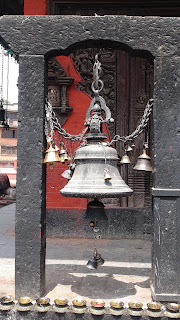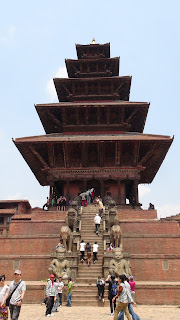When we were putting this trip together, Doug asked me if there were any places on my "bucket list" that I wanted to visit. Obviously Antarctica was one and Easter Island was another, but one that I mentioned that day was Kathmandu. It was a place that had been in my mind for a long time, and I had images of colorful flags, snow-capped mountains, yaks, and Sherpas. I had no idea what to expect or if my expectations were even realistic, but it was one of those exotic-sounding places that I really wanted to see.
For the most part, Kathmandu just looks like a city. Considering that it borders India and most of its people are Hindu, one might expect it to be similar to India, but it really isn't. The architecture, the culture, and the general feeling of being a tourist there are all completely different.
Each passenger had a chance to go up into the cockpit and take pictures through the very clear windows up there. Here is probably the best shot of Everest that we got.
Carter and Doug looking out the window at the mountains.
The pilots were awesome and helped everyone take pictures.
Carter managed not to get too bored on the flight.
One last shot of Mount Everest.
I love baby monkeys especially. So cute!!
The temple grounds are really lovely with incredible architecture.
People walk past rows of prayer wheels and spin them while saying their prayers.
An image of the Buddha in the Buddhist temple.
And here is where my visions of colorful prayer flags really came to life. :-)
More flags! Beautiful.
We next visited Patan's Durbar Square, which is at the center of a city dating back to the 3rd century BC. There were many old temples and examples of thousand-year-old traditional architecture.
Bicycle rickshaw drivers lined up and waiting for business.
I have pictures of Carter running around on quite a few ancient sites now.
The women wearing red are worshiping at this temple.
It took me a few moments to realize that "no killing" actually means "don't kill anything" -- like bugs, etc.
I don't know a heck of a lot about Buddhism, but wise words are wise words universally, I think.
Our next stop was a Hindu temple called Pashupatinath. The first thing that caught my eye were these fires, which turned out to be funeral pyres. Hindus cremate their dead out in the open at temples, and then scatter the ashes into the water below. It was very strange to think that human bodies were burning right before our eyes - we tend to be very separated from death in the US.
The temple complex was huge and crowded with people, but there were areas of peace and quiet as well.
Here Carter is taking a break after a full morning of walking. I thought this was a particularly good picture of him.
One of our final tops was Bhaktapur, another UNESCO world heritage site in the Kathmandu valley. The old part of the city is fantastically well-preserved. The streets are off-limits to cars, but there are motorbikes everywhere, of course.
For the most part, Kathmandu just looks like a city. Considering that it borders India and most of its people are Hindu, one might expect it to be similar to India, but it really isn't. The architecture, the culture, and the general feeling of being a tourist there are all completely different.
We looked into visiting Everest Base Camp, but this is something that is ridiculously expensive to do, so instead we settled for a mountain viewing flight. We didn't get as close to Everest as we had hoped, but we at least got a lovely view of the Himalayas.
Mount Everest is the tallest peak you see here, near the center of the photo.
Each passenger had a chance to go up into the cockpit and take pictures through the very clear windows up there. Here is probably the best shot of Everest that we got.
Carter and Doug looking out the window at the mountains.
The pilots were awesome and helped everyone take pictures.
Carter managed not to get too bored on the flight.
One last shot of Mount Everest.
It was really a fantastic experience. How many people can say they've seen Mount Everest?
The rest of our time in Kathmandu was spent visiting temples and the old parts of the city. Unlike India, Nepal was never colonized by another country and so its history as an independent nation goes back millennia. There are an incredible number of temples in the country. Most people (90% according to our guide) are Hindu, but there are also Buddhists, Muslims, and a tiny amount of Christians. We saw Mormon missionaries walking down the street at one point. There haven't been many places where we haven't seen Mormon missionaries, actually.
One of the first temples we visited was Swayambhu Temple, also known as the Monkey Temple because of the presence of holy monkeys there. This is the oldest religious site in Nepal; there has been a temple on this site for more than 2000 years. Interestingly enough, there are both Hindu and Buddhist temples in the complex.
One of the holy monkeys taking a drink from a fountain.
I love baby monkeys especially. So cute!!
There were beautiful views of the valley and the outskirts of Kathmandu from the hill on which the temple is situated.
The temple grounds are really lovely with incredible architecture.
People walk past rows of prayer wheels and spin them while saying their prayers.
An image of the Buddha in the Buddhist temple.
Carter stopped to look at this shrine for a bit, and I found out afterward that it is the shrine for infertile couples and for parents of sick children.
And here is where my visions of colorful prayer flags really came to life. :-)
Carter spinning the prayer wheels.
We stopped and watched this mother monkey groom her baby for a while.
More flags! Beautiful.
We next visited Patan's Durbar Square, which is at the center of a city dating back to the 3rd century BC. There were many old temples and examples of thousand-year-old traditional architecture.
Bicycle rickshaw drivers lined up and waiting for business.
The palace in Durbar Square.
Ornate wood carvings are everywhere.
As in India, there are cows everywhere. This little calf was curled on on the street asleep. I thought it was a dog at first!
Carter has chased pigeons on many continents now. Somehow it never gets old!
More examples of temples and woodcarving.
Here Carter (in the green shirt) is checking out one of the temples.
The streets around this old city center were narrow and often blocked off from city traffic.
The women wearing red are worshiping at this temple.
There were street children hanging around many of these sites, and I think Carter had a hard time wrapping his brain around the idea that these were kids who might not have families. We had brought some snacks for Carter to eat during the day, but decided to have him give them to the children instead.
At the end of a morning of touring around, we headed back to the hotel to relax for the afternoon. There was a view of a temple from the hotel, though we ran out of time to visit this one.
We attempted to go swimming, but the pool was even too cold for Carter. He gritted his teeth and swam for 10 minutes on the last afternoon, but that was all he could manage.
Another place we visited was the Kopan Monastery, which sits high on a hill overlooking Kathmandu. It's a spiritual retreat and is apparently popular with western visitors.
It took me a few moments to realize that "no killing" actually means "don't kill anything" -- like bugs, etc.
Here Carter is spinning the giant prayer wheel.
There were many small shrines to individuals who have been important figures for the monastery. They are ornate and beautiful, and covered with small Buddha figurines.
The grounds were lovely, the perfect place for a spiritual retreat.
I don't know a heck of a lot about Buddhism, but wise words are wise words universally, I think.
Our next stop was a Hindu temple called Pashupatinath. The first thing that caught my eye were these fires, which turned out to be funeral pyres. Hindus cremate their dead out in the open at temples, and then scatter the ashes into the water below. It was very strange to think that human bodies were burning right before our eyes - we tend to be very separated from death in the US.
The temple complex was huge and crowded with people, but there were areas of peace and quiet as well.
It's still so amazing to me to see cos (or in this case, a bull) just wandering about wherever they like. The colorful dress of the people also stands out in this photo.
Here you see cows and monkeys wandering around!
Here Carter is taking a break after a full morning of walking. I thought this was a particularly good picture of him.
One of our final tops was Bhaktapur, another UNESCO world heritage site in the Kathmandu valley. The old part of the city is fantastically well-preserved. The streets are off-limits to cars, but there are motorbikes everywhere, of course.
Women still do to communal wells to draw water for their household needs. This completely blew my mind, I have to say. We were in the middle of a metropolitan area containing millions of people, with high rise apartment buildings and all the conveniences that come with them, but in this historical area, there wasn't any running water. Amazing.
There were temples all around the central square and another well where women were drawing water. It definitely seemed to be a task they were taking their time with. They chattered away and laughed and smiled the entire time.
This is the tallest structure in Bhaktapur, and I believe this is one of the tallest temples in Nepal.
People pull this cart up the hill is part of a religious festival -- apparently a dangerous one. Our guide said several people were crushed beneath the wheels the last time they did it.
Another place we visited that I don't have any pictures of as the house of Kumari. (Read more about her here.) Kumari is a child who represents a goddess, essentially. She is chosen through a very rigorous process around the age of 3 or 4 and remains the Kumari until she begins to menstruate, at which point she leaves the palace she has lived in her entire life and returns to live with her family. That would have to be an incredibly strange way to spend your childhood!
Overall, Nepal was very different from what I imagined. It was much more cosmopolitan in some ways, and more provincial in others. It was very different from India, but also similar in small ways, in the dress of the people and the ever-present Hindu symbolism. It laced the sense of hustle and bustle and chaos that is ever-present in India, though, it was more laid-back and serene, for lack of a better phrase. We're now in Thailand and I find myself still thinking of Nepal, of its temples and of the people I saw walking down the street, of mountains and prayer wheels and funeral pyres and street children, and colorful flags hanging from every building. I think it will stay with me for quite a while.









































































No comments:
Post a Comment